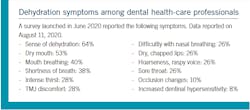Canaries in the coal mine: The rising risk of oral disease among health-care workers
Everyone in the dental office simply loves teeth. Our world revolves around creating sparkling smiles and healthy dentition and helping those whom we care for learn to be the CEOs of their own oral and systemic health. In a world of immediacy, this is no small task.
As health-care providers, our attention naturally gravitates to others. Some feel an inordinate sense of failure when a patient fails to follow our guidance, or worse yet, returns to our treatment room in worse condition than before, or sporting a whole new set of problems.
The complete upheaval of everyone’s lives since the beginning of 2020 has added a whole new layer of complexity to our lives as dental professionals. Now we need to cast the spotlight on the stability of our personal dental health. We are the new canaries in the coal mine.
Elephant in the room
By early spring, reports began showing up about the physical challenges of wearing layers and layers of respiratory personal protective equipment (PPE). Initially there were a few conversations online from dental hygienists, but since most were not back in the clinical environment, their comments flew by most of us. But over the last three months, not a day goes by where there is not at least one chat about what is happening to clinicians who are now back treating patients.
Dental health-care workers are reporting a variety of symptoms that indicate our own oral health is on a negative trajectory. Information from a recent poll of more than 3,500 dental health-care professionals indicated that as workers, we’re simply dehydrated or adopting habits that set the stage for dry mouth. These findings indicate the oral cavity is taking a beating. There are also reports of temporomandibular joint (TMJ) dysfunction, occlusal changes, and increased dentinal hypersensitivity.1
The end result [of dry mouth] is a perfectly balanced microbial community full of pathogens that support one another; the end result of a shift from homeostasis to dysbiosis is disease and destruction.
Understanding our increased risk
Dental professionals are keenly aware that dry mouth syndrome plays a significant role in the development of multiple oral diseases and outcomes. The drier the mouth, the higher the risk for caries, erosion, dentinal hypersensitivity, and oral Candida infections.2-4 Chronic dry mouth issues also underscore multiple quality of life issues.2,4 These are not new principles to anyone in the oral health and wellness arena.
If our crystal balls were working, then perhaps we could quantify our own risk for oral disease. But with no end to the pandemic in sight, it seems prudent for every dental professional to perform his or her own personal risk analysis. The symptoms listed in the sidebar are a great place to start.
Changes in the oral microbiome
Countless research studies over the last couple of decades indicate that a dry oral environment sets the stage for disease. In a Microbiology article, P. D. Marsh actually refers to this as an “ecological disaster.” When the mouth stays dry over a protracted period of time, the composition of the microbial community shifts. The end result is a perfectly balanced microbial community full of pathogens that support one another; the end result of a shift from homeostasis to dysbiosis is disease and destruction.5
While caries and erosion do not have the same etiology, there are similarities. When the mouth is dry, caries and fungal microbes proliferate. These microbes are heavy acid producers. In the case of erosion, the acid source can be a result of dietary intake or the result of acid from regurgitation or reflux. In either case, buffering capacity is diminished or nonexistent when the mouth is dry, so the body’s natural ability to neutralize acids is compromised.2,3
Getting personal data
It is often human nature to overlook or ignore minor symptoms. The recent shift to wearing multiple layers of PPE for long periods of time is magnifying the risks for workers who are masking and gowning up. It is quite easy to determine one’s oral pH value with a high-quality pH paper (MicroEssential Laboratory). Simply moisten a small strip of pH paper in your mouth. Match the strip’s color change to the value grid to determine your actual reading.6
But pH is only part of the story. If your oral pH measures in the acidic range, is your saliva healthy enough to buffer or neutralize acids? Cavity pHighter pH Test Strips (Cao Group) is a new product that tests both pH and buffering in one strip. One test pad records the numerical pH value, and the other shows the buffering capacity as low, medium, or high. It is both easy and inexpensive to keep track of your personal data, and then formulate an appropriate plan.
A potential disaster in the making
The obvious way to deal with dehydration and dry mouth issues is to increase oral and systemic moisture by increasing fluid intake. On the surface this sounds like a great plan, but there are potential pitfalls. Sipping on liquids frequently through the day dilutes the portion of saliva that contains many protective factors such as proteins, bicarbonates, and antimicrobials.2,7,8
When exposed to acid, hard tooth structure is at risk. Enamel can withstand a pH of 5, and if fortified with fluoride, enamel is not vulnerable until the pH goes below 4.5. When the pH value of a beverage or product falls to 6 or below, exposed root structure can begin to demineralize.2,9
Tap water pH values are typically around the safe pH of 7, and unflavored noncarbonated bottled water generally ranges from a pH of 5 to 5.5.Over the last decade, there has been an explosion of beverage products that are meant to flavor plain water using drops or powders. Other commercially prepared water products use natural fruit flavors along with citric acid. In addition, there is an abundance of sports and energy drinks on the market. Currently there is an upsurge of water additives or prepared beverages that claim to improve hydration. While flavorings or additives may seem attractive, consider that the pH values generally range between 3 and 4. Along with being on the lookout for potentially acidic beverages, look for hidden fermentable carbohydrates. It’s important to read product labels and look for terms such as natural cane sugar, honey, agave syrup, corn syrup, glucose, and dextrose.9-11
Dig deeply into any product claim. Is the seller telling the whole story? Are important facts being withheld or presented in a misleading manner? Marketers are adept at using clever words and phrases like “all natural” or attractive images to create a sense of well-being. Slick visuals can be peppered with unsubstantiated testimonials. Ask for scientific substantiation. As dental professionals and consumers, it is important to be armed with accurate information.
Testing pH remedies and understanding titratable acidity
It is just as easy to test the pH values of any hydration product as it is to test salivary pH, but there is one small difference. The pH paper designed to capture beverage pH ranges has a different range than the paper used to test saliva. While testing plain tap water or noncarbonated, nonflavored bottled water is easy, it requires a different, but inexpensive kit specifically designed to test water (MircoEssential Laboratory).
There is one more wild card: titratable acidity (TA), which is a true measure of a product’s erosion potential. Products that contain multiple organic acids will have a higher TA reading. The higher the TA, the longer it will take for the oral cavity to return to neutral. 9-11 Knowing the pH without the TA can lead to a false assumption. There are products that have less acidic pH values than a standard legacy carbonated beverage, but three times the titratable acidity value, so they are therefore considerably more erosive.12
Unless a particular beverage or product has been included in a scientific study, it is hard to find the actual TA value. TA values are calculated in a scientific lab, but it is not out of the question to be wary if a product label lists multiple acidic ingredients. Ingredients that end in “-ic” and “-ate” are acids. Words such as citrate, malic, or tartaric indicate acidic ingredients.
Hydration strategies
Hydration is top of mind. Everyone is experimenting with whether or not to keep on drinking the same amount of fluid throughout the day. Some are limiting fluid intake to reduce the number of restroom visits. Others are maintaining their normal fluid intake but finding that it is simply not enough due to increased perspiration during the day.
Insufficient fluid intake day after day is not an ideal health plan. Not only can this lead to dehydration headaches, exhaustion, and delirium, but lack of sufficient fluid can contribute to urinary tract infections, kidney stones, leg cramps, and other unfavorable health outcomes.13-25 Adequate hydration is also a very important health issue for women who are pregnant or breastfeeding.26,27
The key to adequate and safe hydration is a matter of when and how. While Occupational Safety and Health Administration (OSHA) regulations prohibit beverages in a treatment room, you can take a leadership role in solving a problem that faces everyone in the clinical setting. Work with the doctor and clinical team to establish a beverage-approved zone. Use this article and the data from the survey to justify the need for a hydration plan. Remember, everyone is facing the challenge.
Many clinicians are increasing fluid intake on the way to work. Some are scheduling hydration breaks every couple of hours. Others increase intake during their lunch break. It is also smart to drink as much fluid as possible on the way home from work. Consider keeping a cooler full of reusable frozen water bottles in your car. By the end of the workday, the water will be melted but still refreshingly cool.
Salivary stimulation
Salivary stimulation is another approach. For years people have used hard candy lemon drops to stimulate saliva. Even if the product is sugar-free, citric acid is highly erosive. Dozens of dry mouth products are available now. Many formulas contain acids. While these products may produce saliva, be wary of this route given the lack of buffering in the presence of a dry mouth.28-30 So, unless you can substantiate the product pH, move on.
Xylitol can stimulate salivary flow, bring the pH up to 7, and create an environment where specific caries microbes and Candida organisms can’t thrive.31-38 The key is choosing the right xylitol product that will mesh with your day. Rinses and sprays work well before or after the clinical day, but most clinicians need longer-lasting products when wearing respiratory PPE for hours on end.
There are many ways to deliver long-lasting xylitol therapy. Here are some popular products to consider. Candies such as Epic Xylitol Mints (Elevate Oral Care) and 3M TheraMints and gels such as XyliGel (OraCoat) deliver this important sugar alcohol. Slow-release lozenges, such as XyliMelts (OraCoat), provide long-lasting relief. Salese lozenges (Nuvora) are formulated with essential oils that offer antimicrobial benefits. Cavity pHighter Mints (Cao Group) contain both xylitol and a calcium-soluble compound to support remineralization.
Arginine
The amino acid arginine is simply fascinating. Over the last 50 years, researchers have demonstrated arginine’s value in creating and sustaining neutral oral pH values. Arginine naturally occurs in human saliva. A dozen different oral microbes can metabolize arginine using a unique three-enzyme pathway known as the arginine deaminase system (ADS). The metabolic waste product from the ADS is ammonia, which has the potential to counteract an acidic pH.36,37
Even though arginine is present in saliva, the naturally occurring amount is too low to have a significant impact, but research has shown that regular use of arginine products can create a shift to a neutral oral pH. This not only benefits tooth structure, but this pH shift creates an environment where beneficial microbes can thrive and oral pathogens cannot. In addition, a sustained neutral pH combats acid erosion, helps decrease dentinal hypersensitivity, and enhances tooth remineralization.36-38
There are only three arginine-based products in the US market: Tom’s of Maine Rapid Relief Sensitive toothpaste, BasicBites chews (Ortek Therapeutics), and Colgate Anywhere, Anytime Sensitivity Relief Serum. Each is formulated with 8% arginine bicarbonate/calcium carbonate. Optimal results are obtained when there are two doses of arginine daily. Clinicians can pop in a chew before donning a face mask or simply not rinse after using the paste.
Fluoride and calcium—remineralization
Fluoride is a valuable mineral that can be used to create tooth structure that is more resistant to acid conditions. However, relying on fluoride to be the saving strategy is simply an incomplete plan. In order for fluoride to be deposited into tooth structure, there needs to be a sufficient source of calcium and phosphorus to create hydroxyapatite. The richest source of calcium and phosphorus is saliva. A dry mouth simply can’t provide adequate mineral support.39,40
Every time the oral pH is acidic, valuable tooth structure can be lost. Dynamic pH fluxions create an additional challenge, known as demineralization and remineralization. To accommodate these ongoing changes, fluoride must be delivered frequently and be part of a larger support strategy. It is simply not the only weapon we have against disease.39,40
Dry mouth comfort products
A wide variety of sprays and rinses available today are designed to help retain oral moisture, increase soft tissue comfort, and improve mouth feel. While these products create comfort, most require frequent application.41
Examples of over-the-counter products formulated with a variety of ingredients to protect or improve comfort include Moisyn Spray (Prisyna),42 Hydral Rinse (Sunstar GUM),43 and Hydris Rinse (Colgate). Several prescription remedies include SalivaMax (Forward Science) and 3M Dry Mouth Spray.44 Continuous use of respiratory PPE limits application opportunities, so it is wise to have products readily available for use during a break, while traveling to and from work, or just before bedtime.
A new perspective
While it is important to understand our personal risk for negative oral health outcomes due to dry mouth and act accordingly, there is a silver lining. Prior to wearing all those layers of PPE, did you really understand why dry mouth is so uncomfortable? Sure, we understood that dry mouth increased the risk for disease, but we did not appreciate its impact on the quality of life. As clinicians, our thinking will never be the same.
References
- Guignon A. Survey: Impact of current PPE usage—healthcare professionals. June 2020.
- Sreebny LM, Vissink A, eds. Dry Mouth, the Malevolent Symptom: A Clinical Guide. Wiley Blackwell; 2010.
- Borgnakke WS, Taylor GW, Anderson PF, Shannon MC. Dry mouth (xerostomia): Diagnosis, causes, complications and treatment. Oral and general health–Exploring the Connection. Research Review 2011. Delta Dental Plans Association; 2010. Accessed July 8, 2020. https://www.nedelta.com/SiteMedia/SiteResources/downloads/Forms%20for%20All/Dry_Mouth_Research.pdf.
- Pedersen AML, Sørensen CE, Proctor GB, Carpenter GH, Ekström J. Salivary secretion in health and disease. J Oral Rehabil. 2018;45(9):730-746. doi:10.1111/joor.12664
- Marsh PD. Are dental diseases examples of ecological catastrophes? Microbiology. 2003;149(Pt 2):279-294. doi:10.1099/mic.0.26082-0
- Cunha-Cruz J, Scott J, Rothen M, et al. Salivary characteristics and dental caries: evidence from general dental practices. J Am Dent Assoc. 2013;144(5):e31-e40. doi:10.14219/jada.archive.2013.0159
- Ekstrom J, Khosravani N, Castagnola M, Messana I. Saliva and its control of secretions. In: Ekberg O, ed. Dysphagia. Springer; 2012.
- Mandel ID. The functions of saliva. J Dent Res. 1987;66 Spec No:623-627. doi:10.1177/00220345870660S203
- Lussi A, Schlueter N, Rakhmatullina E, Ganss C. Dental erosion–an overview with emphasis on chemical and histopathological aspects. Caries Res. 2011;45(suppl 1):2-12. doi:10.1159/000325915
- Schlueter N, Luka B. Erosive tooth wear–a review on global prevalence and on its prevalence in risk groups. Br Dent J. 2018;224(5):364-370. doi:10.1038/sj.bdj.2018.167
- Carvalho TS, Schmid TM, Baumann T, Lussi A. Erosive effect of different dietary substances on deciduous and permanent teeth. Clin Oral Investig. 2017;21(5):1519-1526. doi:10.1007/s00784-016-1915-z
- Owens BM, Kitchens M. The erosive potential of soft drinks on enamel surface substrate: an in vitro scanning electron microscopy investigation. J Contemp Dent Pract. 2007;8(7):11-20.
- Popkin BM, D’Anci KE, Rosenberg IH. Water, hydration, and health. Nutr Rev. 2010;68(8):439-458. doi:10.1111/j.1753-4887.2010.00304.x
- Stookey JD. Analysis of 2009–2012 Nutrition Health and Examination Survey (NHANES) data to estimate the median water intake associated with meeting hydration criteria for individuals aged 12–80 in the US population. Nutrients. 2019;11(3):657. doi:10.3390/nu11030657
- Pross N. Effects of dehydration on brain functioning: A life-span perspective. Ann Nutr Metab. 2017;70(suppl 1):30-36. doi:10.1159/000463060
- Pross N, Demazières A, Girard N, et al. Influence of progressive fluid restriction on mood and physiological markers of dehydration in women. Br J Nutr. 2013;109(2):313-321. doi:10.1017/S0007114512001080
- Armstrong LE, Ganio MS, Casa DJ, et al. Mild dehydration affects mood in healthy young women. J Nutr. 2012;142(2):382-388. doi:10.3945/jn.111.142000
- Zhang N, Du SM, Zhang JF, Ma GS. Effects of dehydration and rehydration on cognitive performance and mood among male college students in Cangzhou, China: A self-controlled trial. Int J Environ Res Public Health. 2019;16(11):1891. doi:10.3390/ijerph16111891
- Benton D, Young HA. Do small differences in hydration status affect mood and mental performance? Nutr Rev. 2015;73(suppl 2):83-96. doi:10.1093/nutrit/nuv045
- Masento NA, Golightly M, Field DT, Butler LT, van Reekum CM. Effects of hydration status on cognitive performance and mood. Br J Nutr. 2014;111(10):1841-1852. doi:10.1017/S0007114513004455
- Khorsha F, Mirzababaei A, Togha M, Mirzaei K. Association of drinking water and migraine headache severity. J Clin Neurosci. 2020;77:81-84. doi:10.1016/j.jocn.2020.05.034
- Blau JN, Kell CA, Sperling JM. Water-deprivation headache: a new headache with two variants. Headache. 2004;44(1):79-83. doi:10.1111/j.1526-4610.2004.04014.x
- Watso JC, Farquhar WB. Hydration status and cardiovascular function. Nutrients. 2019;11(8):1866. doi:10.3390/nu11081866
- Stookey JD, Kavouras SA, Suh H, Lang F. Underhydration is associated with obesity, chronic diseases, and death within 3 to 6 years in the U.S. population aged 51-70 years. Nutrients. 2020;12(4):905. doi:10.3390/nu12040905
- Pross N. Effects of dehydration on brain functioning: A life-span perspective. Ann Nutr Metab. 2017;70(suppl 1):30-36. doi:10.1159/000463060
- Zhou Y, Zhu X, Qin Y, et al. Association between total water intake and dietary intake of pregnant and breastfeeding women in China: a cross-sectional survey. BMC Pregnancy Childbirth. 2019;19(1):172. doi:10.1186/s12884-019-2301-z
- Zhang N, Zhang F, Chen S, et al. Associations between hydration state and pregnancy complications, maternal-infant outcomes: protocol of a prospective observational cohort study. BMC Pregnancy Childbirth. 2020;20(1):82. doi:10.1186/s12884-020-2765-x
- Delgado AJ, Olafsson VG, Donovan TE. pH and erosive potential of commonly used oral moisturizers. J Prosthodont. 2016;25(1):39-43. doi:10.1111/jopr.12324
- Delgado AJ, Olafsson VG. Acidic oral moisturizers with pH below 6.7 may be harmful to teeth depending on formulation: a short report. Clin Cosmet Investig Dent. 2017;9:81-83. doi:10.2147/CCIDE.S140254
- Tayee P, Hsu A, Messer R, et al. Evaluation of pH values of products managing xerostomia. Augusta University Dental College of Georgia. Accessed July 8, 2020. https://cdn.shopify.com/s/files/1/0035/3832/files/Tayee_et_al-_Ph_values_of_xerostomia_products_2015.pdf
- Salli K, Lehtinen MJ, Tiihonen K, Ouwehand AC. Xylitol’s health benefits beyond dental health: a comprehensive review. Nutrients. 2019;11(8):1813. doi:10.3390/nu11081813
- Ho J, Firmalino MV, Anbarani AG, Takesh T, Epstein J, Wilder-Smith P. Effects of a novel disc formulation on dry mouth symptoms and enamel remineralization in patients with hyposalivation: an in vivo study. Dentistry (Sunnyvale). 2017;7(2):411. doi:10.4172/2161-1122.1000411
- Ribelles Llop M, Guinot Jimeno F, Mayné Acién R, Bellet Dalmau LJ. Effects of xylitol chewing gum on salivary flow rate, pH, buffering capacity and presence of Streptococcus mutans in saliva. Eur J Paediatr Dent. 2010;11(1):9‐14.
- Bots CP, Brand HS, Veerman EC, et al. Chewing gum and a saliva substitute alleviate thirst and xerostomia in patients on haemodialysis. Nephrol Dial Transplant. 2005;20(3):578‐584. doi:10.1093/ndt/gfh675
- Cocco F, Carta G, Cagetti MG, Strohmenger L, Lingström P, Campus G. The caries preventive effect of 1-year use of low-dose xylitol chewing gum. A randomized placebo-controlled clinical trial in high-caries-risk adults. Clin Oral Investig. 2017;21(9):2733‐2740. doi:10.1007/s00784-017-2075-5
- Liu YL, Nascimento M, Burne RA. Progress toward understanding the contribution of alkali generation in dental biofilms to inhibition of dental caries. Int J Oral Sci. 2012;4(3):135‐140. doi:10.1038/ijos.2012.54
- Huang X, Schulte RM, Burne RA, Nascimento MM. Characterization of the arginolytic microflora provides insights into pH homeostasis in human oral biofilms. Caries Res. 2015;49(2):165‐176. doi:10.1159/000365296
- Nascimento MM. Potential uses of arginine in dentistry. Adv Dent Res. 2018;29(1):98-103. doi:10.1177/0022034517735294
- Horst JA, Tanzer JM, Milgrom PM. Fluorides and other preventive strategies for tooth decay. Dent Clin North Am. 2018;62(2):207-234. doi:10.1016/j.cden.2017.11.003
- Dai Z, Liu M, Ma Y, et al. Effects of fluoride and calcium phosphate materials on remineralization of mild and severe white spot lesions. Biomed Res Int. 2019;2019:1271523. doi:10.1155/2019/1271523
- Łysik D, Niemirowicz-Laskowska K, Bucki R, Tokajuk G, Mystkowska J. Artificial saliva: challenges and future perspectives for the treatment of xerostomia. Int J Mol Sci. 2019;20(13):3199. doi:10.3390/ijms20133199
- Epstein JB, Villines DC, Singh M, Papas A. Management of dry mouth: assessment of oral symptoms after use of a polysaccharide-based oral rinse. Oral Surg Oral Med Oral Pathol Oral Radiol. 2017;123(1):76‐83. doi:10.1016/j.oooo.2016.09.008
- Russo E, Selmin F, Baldassaria S, et al. A focus on mucoadhesive polymers and their application in buccal dosage forms. J Drug Delivery Sci Technol. 2016;32(Part B):113-125. doi:10.1016/j.jddst.2015.06.016
- Furness S, Worthington HV, Bryan G, Birchenough S, McMillan R. Interventions for the management of dry mouth: topical therapies. Cochrane Database Syst Rev. 2011;(12):CD008934. doi:10.1002/14651858.CD008934.pub2









